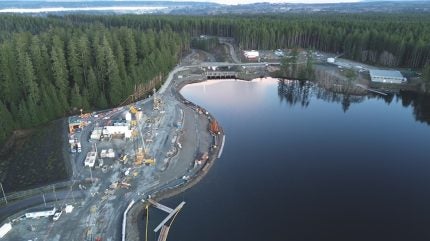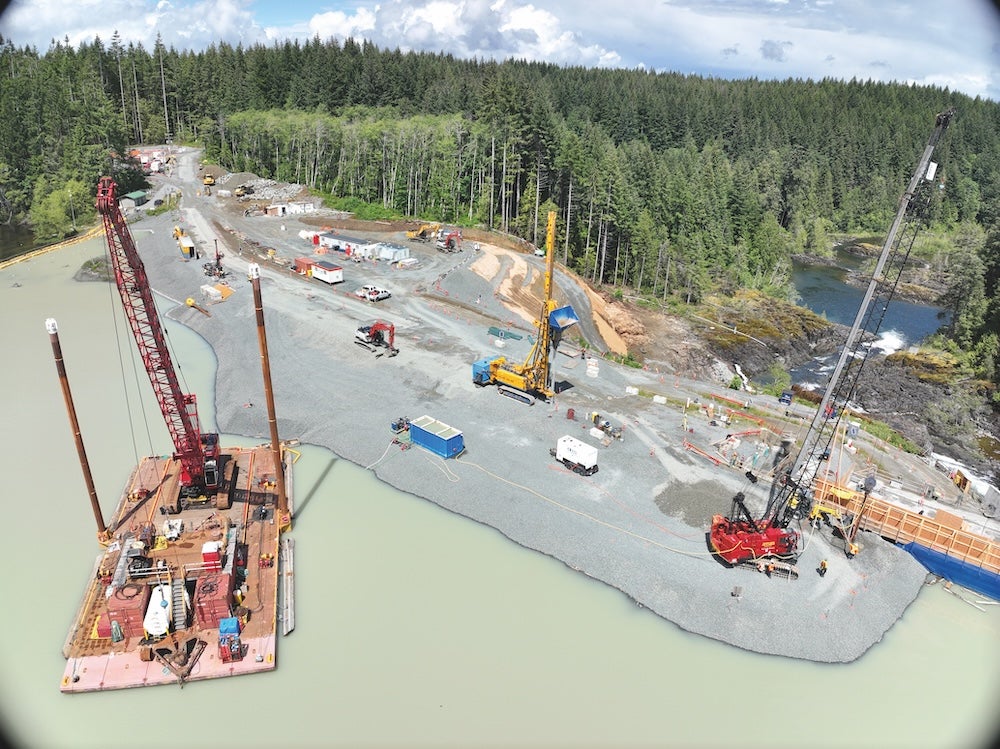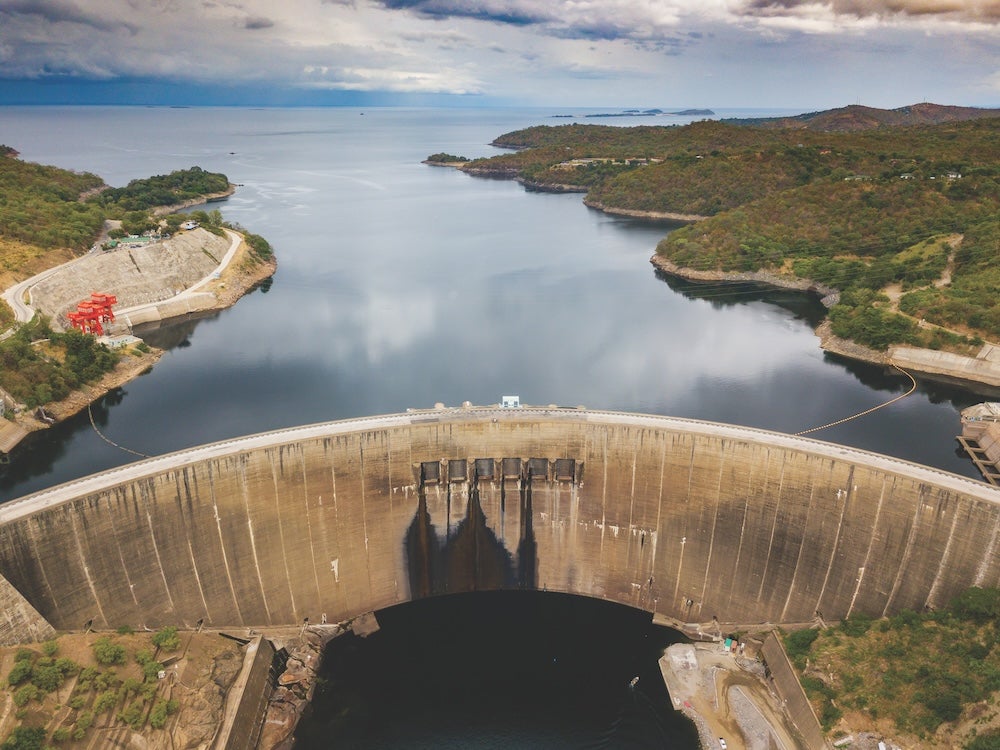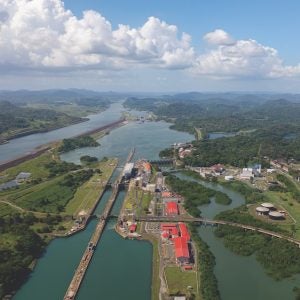
One of three dams on the Campbell River on Vancouver Island in Canada, the John Hart Dam was built in 1947. Designed with seismic considerations based on the information available at the time, there is now greater understanding of the risks posed by earthquakes in what’s known as the Cascadia Subduction Zone.
With a major earthquake occurring on an average of about every 500 years, and with a range of 300 and 800 years between events, it means one could be due at any time. So that’s why seismic upgrades are now underway at BC Hydro’s dam.
Located just a six-minute drive upstream from the town of Campbell River, the dam passes water to generate power at the John Hart Powerhouse, provides flood risk management operations, supplies the City of Campbell River with drinking water, as well as providing water for spawning habitat in an area known as the Salmon Capital of the World.
Over the past ten years, BC Hydro has replaced the downstream generating station at John Hart to meet seismic standards, maintain reliability, and protect fish habitat, and is now in the process of rebuilding the dam itself. Once completed, it will be able to withstand a 1-in-10,000-year event, a severe earthquake of magnitude 9.0 or stronger.
Started in 2023, the six-year John Hart Seismic Upgrade Project is part of BC Hydro’s recently announced C$36 billion, ten-year plan to sustain and upgrade existing assets including BC’s network of dams, transmission lines, and substations.
BC Hydro says the current upgrades – mainly through ‘widening’ of the dam base through the addition of upstream and downstream berms, and the insertion of an additional water seepage barrier in the dam itself – are designed to bolster the ability of the dam to withstand the severe shaking of a quake.

Water seepage barrier
Bauer Foundations Canada, a subsidiary of Bauer Spezialtiefbau GmbH, was recently tasked with executing the new water seepage barrier within the main earthfill section of the dam.
The project, which is managed by Aecon/EBC General Partnership, includes constructing a low permeability plastic concrete cut-off wall on the middle earthfill dam to improve the water barriers and seismic performance of the earthfill section. In addition to the cut-off wall works, Bauer performed soil improvement on the soft sediments to reinforce the north earthfill dam.
Bauer’s construction tasks included installation of the plastic concrete cutoff wall as well as land and marine densification for the new upgraded eart-fill berms. A major challenge was minimising the environmental impact to the reservoir, Campbell River and surrounding park during construction, particularly close to the drinking water extraction point for Campbell River. The work began in October 2023 and was successfully completed in July 2024. Another phase of soil improvement will follow in 2025.
The modernisation of the John Hart Dam involved a variety of technical and logistical challenges.
“As a result, precise planning and the latest equipment were essential for work on Vancouver Island where variable soils and a hard basalt bedrock layer are present,” Project Manager Jeffrey Pattison said.
Among other equipment, two Bauer MC 96 duty-cycle cranes, one equipped with a DHG V hydraulic grab and one with a BC 48 cutter, three BE desander systems from Bauer MAT Slurry Handling Systems, and one Bauer BG 30 were used for this work. The wintry conditions as well as the limited working space on both earthfill dams, made work even more difficult. In order to meet these challenges successfully, the project team relied on innovative technologies and digital tools such as b-tronic and Virtual Site Installer (VSI).
As a result, it was possible not only to monitor work in real time, but also to adapt processes accordingly as needed. Bauer says, thanks to the support of the experienced team on site as well as laboratory tests carried out in Germany, the quality of the plastic concrete used for the cut-off wall was optimised.
The seismic upgrade of the John Hart Dam has been described as a milestone from a technical and ecological standpoint. The extensive works will help to safeguard the regional water supply while minimising the environmental impact at the same time, and Pattison says Bauer was proud to have made an important contribution to the region with the successful completion of a challenging aspect of the dam safety upgrade.
BC Hydro’s upgrading project at John Hart dam will also include permanent flood and flow upgrades, notably a new overflow spillway below the road deck on top of the dam and replacement of three spillway gates and related works, such as the hoist system.
Furthermore, new and/or upgraded spillway gates on all three of the Strathcona, Ladore and John Hart dams in the system, will allow improved flow regulation in the event of a major earthquake.
Kariba Dam
The Zambezi River Authority recently confirmed the occurrence of earthquake incidents in the region surrounding the Kariba Dam. The most recent incident with a magnitude M4.9 occurred on 23 December 2024, with its epicentre approximately 19km from Kariba Dam at a depth of 10km. This region is located within the Kariba reservoir, directly behind the Antelope Island in Zimbabwe.
In a press release, the authority stated it: “wishes to advise its stakeholders and the public at large that earthquakes are primarily reservoir-induced-seismic (RIS) activities that are triggered by not only the presence, but also the water level fluctuations from the drawing down of the Kariba reservoir. The earthquakes are not only limited to Kariba as they have been reported from the filling and subsequent operation of several other large dams and reservoirs worldwide”.
In the interest of dam safety, the authority went on to say it doesn’t focus on magnitudes of the earthquakes, but the ground accelerations or vibrations generated from the event. The vibrations/shaking are further influenced by such characteristics as distance and depth of the epicentre. Therefore, an earthquake with a smaller magnitude but with its epicentre closer to the dam wall could be more damaging than a large earthquake with an epicentre located far away from the dam wall.
“Within this context,” Zambezi River Authority stated, “the earthquakes that have been experienced in Kariba, Siavonga and surrounding areas since the construction of the Kariba Dam are relatively small and have not generated large ground accelerations or vibrations as to cause concern regarding the safety of the dam wall.”
As part of emergency preparedness and standard operating procedures following the occurrence of unusual incidents, the authority inspects the dam and analyses data from the various dam monitoring instruments each time there is an an earthquake incident. These did not reveal any unusual observations and the dam continued to exhibit normal behaviour that is consistent with prevailing loading conditions.
The Zambezi River Authority is a bilateral organisation jointly owned by the Governments of the Republics of Zambia and Zimbabwe with the primary function to operate, maintain, monitor and regulate the water level in the Kariba Reservoir on the Zambezi River.

Station safety
Seismic activity is highly complex, and even with advanced data analytics tools, there are still many unknown factors that influence when and where an earthquake will strike. As such, current efforts are focused on improving understanding of seismic phenomena and developing more sophisticated tools to detect and respond to earthquakes as they occur.
This is what Tao Song et al have set out to achieve in their recent paper published in Frontiers in Environmental Science. Here the researchers focused on maximising hydropower station safety against earthquakes through extreme learning machine-enabled shear waves velocity prediction.
As the authors explain, to evaluate the potential shear rate of surrounding rock layers, the shear wave velocity (Vs) parameter can be a useful tool. This parameter helps to determine the velocity at which shear waves travel through the rock layers, which can indicate their stability and susceptibility to earthquakes.
This study investigated the significance of the Vs parameter in evaluating the potential shear rate of rock layers surrounding hydropower stations and how it can be used to ensure their safety and efficiency in earthquake-prone regions.
Furthermore, the researchers say they proposed a novel approach which involves using extreme learning machine (ELM) technology to predict Vs and enhance the seismic safety of hydropower stations. The ELM model predicts the Vs of the soil layers around the hydropower station, a crucial factor in determining the structure’s seismic response. The predicted Vs is then used to assess seismic hazard and then design appropriate safety measures.
In this study, a large dataset of 3200 data points was analysed to gain insights into the rock formations of hydropower plants’ foundations. The dataset contained information about measured depth, rock type, gamma ray log, thermal neutron porosity, shallow electrical resistivity, deep electrical resistivity, compressive wave velocity (Vp), and shear wave velocity (Vs) recorded during vertical seismic logging.
The study used four newly developed models and it was found that the multi-layered extreme learning model (ML-ELM) outperformed both the ELM and empirical models, as well as fewer outlier data predictions. Although ELM is simpler and faster than ML-ELM, since it has only one hidden layer with random weights and does not involve backpropagation, ML-ELM has the advantage of learning more complex patterns in data due to its multiple hidden layers with non-linear transformations.
The authors believe this approach shows promise for predicting Vs in similar environments, and future research could explore its effectiveness in other datasets and practical application.






